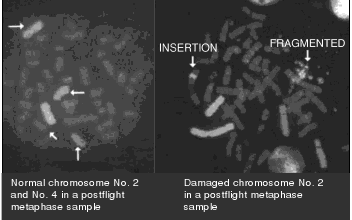Outside of our planet's protective atmosphere is a universe full of radiation, a process in which energetic particles or waves travel through a medium or space. Though we're constantly exposed to radiation from the buildings we live and work in, the air around us, and the Earth itself, astronauts are exposed to higher levels of radiation in space. This can be dangerous because space radiation is different than the smaller levels of radiation, such as X-rays and gamma-rays, that we're familiar with here on Earth. Space radiation consists primarily of ionizing radiation, which exists in the form of high-energy charged particles.
Space radiation is made up of three types of radiation that represent ionizing radiation: particles trapped in the Earth's magnetic field; particles shot into space during solar flares; and galactic cosmic rays, which are high-energy protons and heavy ions from beyond our solar system.
The effects of space radiation
If we were to come in contact with space radiation, it would have different effects on our DNA, cells, and tissues, compared to the radiation we experience beneath Earth's atmosphere. This is because of the increased ionization that takes place near the track a particle of space radiation takes through a material. Because it's packed with so much energy, ionizing radiation can knock the electrons out of any atom it strikes, ionizing the atom. This effect is known to damage the atoms in human cells, leading to health problems in the future, including cancer, cataracts, and damage to the central nervous system.
Ionizing radiation loses energy as it travels through a material or living tissue, and that energy is absorbed by the material or living tissue. The ionization of water and other cell components can damage DNA molecules near the path the particle takes, breaking the DNA strands, which isn't easily repaired by cells. When exposed to the types of radiation on Earth, breaks in DNA strands are much less frequent.
Protecting space station crews
For astronauts, space radiation effects depend on the amount of radiation, such as fast-moving particles and X-rays, that pass through the walls of their spacecraft or space station and penetrate into their bodies. At the International Space Station, the daily dosage of radiation is equal to about eight chest X-rays per day.

The International Space Station. Image via nasa.gov.
In order to protect astronauts from dangerous levels of radiation, NASA follows the standard radiation protection practices recommended by the U.S. National Academy of Sciences Space Science Board and the U.S. National Council on Radiation Protection and Measurements. By improving the amounts and types of shielding in the most frequently occupied locations, such as the sleeping quarters and the galley aboard the International Space Station, the crew's exposure to space radiation is reduced. Each astronaut also wears physical dosimeters, and undergoes a biodosimetry evaluation, which measures radiation damage to chromosomes in blood cells.

Image via nasa.gov.
While orbiting the Earth, the amount of radiation astronauts are exposed to depends on a number of factors.
- Orbital inclination is very important. The closer a spacecraft is to the Earth's poles, where the planet's magnetic field concentrates ionizing particles, the higher the radiation levels will be.
- The altitude above the Earth also plays a substantial role. At higher altitudes, the Earth's magnetic field is weaker, resulting in less protection against ionizing particles, allowing astronauts aboard the spacecraft to pass through the trapped radiation belts more often.
- The sun's 11-year solar cycle has a lot to do with the effects radiation has on astronauts. During periods where the sun has numerous sunspots, there's a dramatic increase in the number and intensity of solar flares, which are bursts of radiation known to be our solar system's largest explosive events.
Researchers at NASA continue to quantify the amounts of space radiation astronauts face aboard the International Space Station and in our own solar system. Understanding space radiation protects the current explorers aboard the International Space Station as well as those who will continue the exploration of our solar system in the future.
For more details on space radiation, download the research paper below.
Advertisement
Learn more about Nasa





